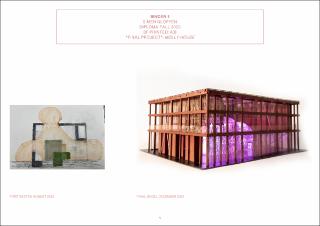Molly House
Master thesis
Permanent lenke
https://hdl.handle.net/11250/3120252Utgivelsesdato
2023-12Metadata
Vis full innførselSamlinger
Beskrivelse
What is a Molly House? “Molly houses” were locations in Britain where, in the 18th and early 19th centuries, mollies, or Queer men, met for companionship. This project is trying to investigate how architecture can contribute to a more diverse society. This project is architecture based on a hidden voice, in this case Norway’s first known drag performer, and first foreman of The Oslo Student Organization, Peter Munch Wang.
Peter Munch Wang was born in 1792 in Trysil. He moved to Gudbrandsdalen when he was 11. When he was a late teenager he moved to Christiania for studies. Here he became an actor and the first foreman for the Oslo Student Organization. According to old diaries he had four main interest: He was an expert on hosting tea parties, an activity which was called female in his time. He was eager to get new literature into the studies. He was also a well known actor in female clothes, and loved it. He also carried a secret, he was most likely homosexual. He was thrown out of the boys dorm in Christiania after accusations of sodomy. He was forced back to his farm in Gudbrandsdalen. Here he continued hosting festivities, mostly weddings. He drank the alcohol that was left behind after his arrangements, and he died 49 years old, probably from depression and drinking. In the church book he is titulated ”student”.
His four main interests (tea, literature, drag and his secrets), his personality and history has inspired this project, in terms of materiality, construction, the program and the spacial investigation. What happens if you starting point of creating architecture is a hidden voice, an unkown story from the society we live in. Will we end up with a more diverse architecture if we let hidden voices inspire us?
DIVERSITY IN ARCHITECTURE
The city of Oslo appears today with a certain story. A certain narrative. Our society is slowling getting more and more diverse, but does the story the architecture tells follow the diverse development in humans?
NEW STORIES INTO THE LIGHT
If we want to create a city we can feel we belong in, feel ownership to and feel a part of, the solution might not be to create spaces for ”everyone”. Will we end up feeling more connected to the surrounding architecture, if we in stead make spaces specific for someone? And will these spaces in the end be for everyone after all? Hidden stories should be brought into the light, and they should affect us when we walk down a road, or when we enter a building. If we revealed some of the diversity that has allready existed in Oslo during it’s time as a place for humans, will the diverse humans of Oslo connect more to the architecture?
THE DIG
I will try to dig into our own history and bring hidden voices from the past up an into the our awareness.
And let one hidden voice inspire my diploma.
MY DIPLOMA
In my work with this diploma I started out studying hidden voices, and which voices that might have been forgotten through the years. As I personally has a great interest in queer art and social life, I was curious to find out who Norway’s first drag perfomer was. I was quite sure that he was still alive, and my hopes was to interview this person. To my surprise, he was not a live at all. In fact he was born in 1792 and his name was Peter Much Wang.Why hadn’t I heard of him?I started my research about him and found old journals and old recensions from plays he participated in. In addition to being Norway’s firs drag performer, he also was a part of founding Norway Student Organization.
Why isn’t this a man I have heard of?
According to old diaries he had four main interest: He was an expert on hosting tea parties, an activity which was called female in his time. He was eager to get new literature into the studies. He was also a well known actor in female clothes, and loved it. He also carried a secret, he was most likely homosexual. He was thrown out of the boys dorm in Christiania after accusations of sodomy. He was forced back to his farm three hours away from Oslo. Here he continued hosting festivities, mostly weddings. He drank the alcohol that was left behind after his arrangements, and he died 49 years old, probably from depression and drinking. In the church book he is titulated ”student”.
WORKING METHOD
I let my main man, Peter Munch Wang decide my program:
DRAG CLUB - TEA HOUSE - LIBERARY - SECRETS
It became a queer culture house, with these four programmes in mind. I have mainly worked in models.
During my investigation in models I asked myself these questions:
-Like a person with secrets, how can architecture inhence this state of mind?
-How can architecture keep a secret?
-How can a building awake curiousness?
-How can architecture be safe, but not exposed?
-How to keep the queer society exposed - yet still safe?
VOCABULARY
I reflected on the queer community today, and how this part of society is growing quickly. It’s easy to observe queer humans when you walk in the streets of Oslo, but not that easy to see in our surrounding architecture. I created a vocabulary I wanted to work with which both could be terms in architecture and in a queer life:
-Observe
-Learn
-Contemplate
-Curiousity
-Meet
-Hide
-Explore
